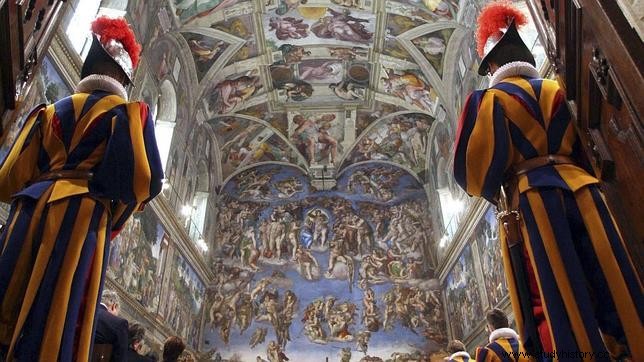The Sistine Chapel It was built between 1471 and 1483 by order of Pope Sixtus IV , to which he owes his name. It was the result of rehabilitating and expanding the Capilla Magna , an old fortified medieval hall where the meetings of the papal court took place and, from then on, it would become the venue for the election of each Pope in the conclave of the College of Cardinals. And since Sixtus IV was one of those who thought that history would judge him by his works -of art, not by his way of acting-, he commissioned the frescoes in the chapel from the most famous Florentine painters:Sandro Botticelli, Domenico Ghirlandaio, Cosimo Rosselli, Pietro Perugino… In 1483 the chapel was inaugurated with a ceremony in which it was consecrated and dedicated to the Virgin Mary.

Catholic tradition places the St. Peter's Basilica on the tomb of the first bishop of Rome, Saint Peter. The construction of the current building, on a 4th century basilica at the time of Emperor Constantine the Great , began in 1506 by order of Pope July II , nephew of Sixtus IV, and ended in 1626. To the credit of Julius II we must also add the fact that he ordered the great Michelangelo the decoration of the vault of the Sistine Chapel. Although he was reluctant at first, he accepted the commission when he got creative freedom from the Pope:a set of frescoes depicting the history of the world and the cosmos before Jesus Christ.

It is very difficult to quantify the enormous cost of these two emblematic constructions but, like a Spanish politician with his airport projects, nothing was going to stop the airs of greatness of uncle and nephew... and least of all the financing.

Sixtus IV
Sixtus IV was ahead of his time, as he legalized prostitution in Rome -if we understand by legalizing taxing the activity with a tax-. All prostitutes had to pay a tribute to exercise their profession and, seeing that this brought huge benefits, he decided to extend that tax to all members of the clergy who maintained barraganas and to members of the nobility who wanted to have free access to the bed of a young woman. maid. But there was still his masterpiece: the sale of indulgences . According to the RAE, indulgences are the remission before God of the temporary penalty corresponding to sins already forgiven, which is obtained through the mediation of the Church; in the words of Sixtus IV…
Those who died in the light of Christ's charity can be helped by the prayers of the living. And not only that. If alms are given for the needs of the Church, souls will gain God's indulgence.
It became a real market in which the Pope obtained financing and the buyers the forgiveness of their sins. But Sixto went a little further, he could also make a cut with the dead. To date, the beneficiaries of the indulgences were the living, but now the living could buy a ticket on a luxury cruise so that their deceased could leave the terrifying purgatory, where sorrows were redeemed, and reach the heavenly paradise. Another advantage of this market, unlike previous Popes who sold relics more false than Judas or obtained from looting tombs of saints, was that by not giving anything in return it was an inexhaustible product. A legion of clergymen toured cities and towns selling smoke that the God-fearing bought for the benefit of their deceased.

Julius II
To July II , the Warrior Pope , more than a leader of the Church he could be considered a monarch. He liked to wear the armor and drink with his soldiers; he fought against the Borgias and their allies, against Venice and against the French. These wars involved precious booty that was largely used to finance architectural works and hire the best artists of the time. In addition, and following in the footsteps of his uncle, he also obtained significant income from prostitution but adding another source:he created his own brothel . And it even seems that Julius II was the one doing the castings to hire professionals. In 1508, on Good Friday, it was not allowed to kiss the Pope's feet due to the ulcerations that covered them, typical of the Gallic morbidity or bad French . He died of syphilis, perhaps contracted at the castings.
Sources:Of the human and the divine, The Popes and Sex – Eric Frattini
